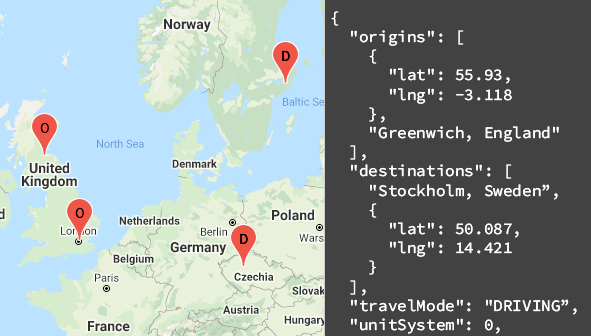소개
Distance Matrix API (기존)는 특정 이동 수단의 출발지와 목적지가 포함된 HTTPS 요청을 수락하는 서비스입니다. 출발지와 목적지의 각 조합에 대해 이동 거리와 시간을 반환합니다.
Distance Matrix API를 사용해야 하는 이유
Distance Matrix API를 사용하면 가능한 여러 출발지와 목적지 간 가장 효율적인 이동 경로를 파악할 수 있습니다. 예를 들어 작업 현장에 보낼 작업자나 패키지를 보낼 창고를 결정합니다.
Distance Matrix API로 할 수 있는 작업
Distance Matrix API를 사용하면 출발지와 목적지 행렬에 대한 이동 거리와 시간을 제공할 수 있습니다. 운전, 자전거, 대중교통, 도보와 같은 이동 수단과 버스, 지하철, 기차, 트램, 철도와 같은 대중교통 수단을 비롯한 여러 옵션을 지정할 수 있습니다.
Distance Matrix API는 시작 지점과 종료 지점 간의 추천 경로를 기반으로 정보를 제공합니다. 다음과 같은 거리 데이터를 요청할 수 있습니다.
- 선택한 이동 모드의 거리
- 거리(킬로미터 또는 마일)
- 교통 상황을 고려한 예상 이동 시간

Distance Matrix API의 작동 방식
Distance Matrix API는 원하는 수의 출발지 (시작 지점)와 목적지를 사용하며, 요청의 첫 번째 출발지부터 시작하여 다음 출발지로 단계적으로 진행하면서 각 출발지와 요청된 모든 목적지 간의 거리와 이동 시간을 반환합니다.
예를 들어 요청에서 A와 B를 출발지로, C와 D를 도착지로 지정하면 다음과 같은 순서로 거리와 이동 시간을 반환합니다.
- A~C
- A~D
- B~C
- B~D
다음 예는 워싱턴 DC와 보스턴이라는 두 출발지와 뉴욕시라는 단일 목적지를 JSON 형식으로 요청하는 방법을 보여줍니다.
https://maps.googleapis.com/maps/api/distancematrix/json ?destinations=New%20York%20City%2C%20NY &origins=Washington%2C%20DC%7CBoston &units=imperial &key=YOUR_API_KEY
리소스
다음 표에는 Distance Matrix API를 통해 사용할 수 있는 리소스와 반환되는 데이터가 요약되어 있습니다.
| 데이터 리소스 | 반환된 데이터 | 반환 형식 |
|---|---|---|
| 거리 행렬
장소 ID, 주소 또는 위도/경도 좌표 형식으로 출발지와 도착지를 제공합니다. |
|
|
Distance Matrix API 사용 방법
| 1 | 설정하기 | Google Cloud 프로젝트 설정하기부터 시작하여 이어지는 설정 안내를 완료합니다. |
| 2 | 거리 행렬 요청 시도 | API 키가 있으면 브라우저에서 바로 Distance Matrix API를 테스트할 수 있습니다. 예시는 시작하기 가이드의 요청 샘플을 참고하세요. |
| 3 | 더 복잡한 요청 작성하기 | 여러 출발지와 목적지를 제공하는 요청을 시도해 보세요. 지정된 출발 시간이나 경로 제한과 같이 계산을 제한하는 선택적 매개변수에 대해 알아봅니다. 거리 행렬 요청 및 응답 가이드의 선택적 매개변수를 참고하세요. |
| 4 | 대답 기본사항 이해하기 | 앱에서 거리 매트릭스 데이터를 사용할 수 있도록 데이터 응답을 살펴봅니다. 자세한 내용은 거리 매트릭스 응답을 참고하세요. |
| 5 | 자체 앱에 거리 매트릭스 데이터를 통합하세요. | 이 데이터를 사용하여 이동 거리와 시간을 계산할 수 있습니다. |
사용 가능한 클라이언트 라이브러리
다음 클라이언트 라이브러리 중 하나를 통해 원하는 언어로 이 API를 호출합니다.
- Google 지도 서비스용 Java 클라이언트
- Google 지도 서비스용 Python 클라이언트
- Google 지도 서비스용 Go 클라이언트
- Google 지도 서비스용 Node.js 클라이언트
Google 지도 서비스용 Java Client, Python Client, Go Client, Node.js Client는 커뮤니티 지원 클라이언트 라이브러리로, Apache 2.0 라이선스에 따라 오픈 소스로 제공됩니다. GitHub에서 다운로드하세요. GitHub에서는 설치 안내와 샘플 코드도 찾을 수 있습니다.
다음 단계
- 거리 행렬 사용 시작하기: 시작하기로 이동합니다.
- 샘플 요청 및 응답 시작하기: 거리 행렬 요청 및 응답으로 이동합니다.
- 권장사항 준수: 웹 서비스 권장사항으로 이동하세요.

